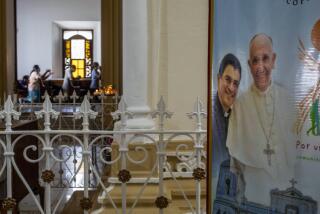After 125 Years, Vatican, Mexico Restore Ties
- Share via
VATICAN CITY — Ending more than a century of official estrangement punctuated by revolution and suppression, the Vatican on Monday formally resumed diplomatic relations with Mexico, one of the world’s largest Roman Catholic countries.
“An old anachronism has been overcome,” Vatican spokesman Joaquin Navarro told reporters. “These new relations are not an end in themselves, but a framework that will permit the church to operate normally in Mexico.”
Under an agreement announced in a Vatican communique Monday, five days after the 171st anniversary of Mexican independence, Mexico and the Holy See will exchange ambassadors for the first time since separation of church and state was decreed by Mexico’s revolutionary president, Benito Juarez, in the middle of the 19th Century.
The Juarez government confiscated church properties and banned religious orders in a move to end domination of the nation’s public affairs by the church and its wealthy, conservative patrons.
“With this decision, Mexico brings itself into line with the international practice by nearly all modern states to have relations with the Catholic Church, its institutions, and the Holy See,” Navarro said.
Resumption of Mexico-Vatican ties was marked in Mexico City by sober newspaper editorials, one of which, in the government newspaper El Nacional, noted that the move represents “a formalization of informal relations that have been going on for some time.”
El Nacional reminded its readers that Mexico’s original rupture with the church “had real motives. It was not a capricious or casual” act, but “a guarantee that the church would respect . . . the need for strict secularism in public affairs. . . .”
Excelsior, one of Mexico City’s most important daily newspapers, recalled that Mexico’s break with the Vatican had been “an imperative necessity to control a church that had gone too far.”
The newspaper also warned that conservative sectors of the church may try to portray the new ties “as if there were . . . a political change in the state-church relation in our country. Nothing is less true. The government is secular and so is official education. . . .”
The new relations, Excelsior wrote “do not mean that the church is going to acquire more influence in our government or among our people. Relations between Mexico and the Vatican will have to be subject to the free will of both sides.”
With a population of 86 million people, more than 90% of them baptized in the Roman Catholic Church, Mexico is the largest Catholic country in the world after Brazil. Yet until constitutional reforms early this year, the church had held no juridical status for most of this century.
Bishops administered Catholic schools, for example, without any legal right to teach in a country where anticlericalism is still an important local issue.
A kind of undeclared truce that developed between the church and the Institutional Revolutionary Party, Mexico’s governing political party since the late 1920s, permitted visits to Mexico by Pope John Paul II in 1979 and again in 1990.
“The visits had a certain surreal dimension,” Navarro said here, because the Pope represented an institution blackballed by the Mexican constitution.
Peace prospects blossomed following the election of President Carlos Salinas de Gortari in 1988.
Salinas and the Pope exchanged personal representatives in February, 1990, and last year, after visiting the Vatican, Salinas announced that his government would move toward renewed diplomatic ties with the Holy See.
Mexico was the only major Latin American country that did not have formal links with the Vatican.
Catholic priests went to Mexico with the first Spanish conquistadores in the 16th Century, and the religion quickly spread among conquered Indian nations there. Criticized by modern historians as an exploiter of the Indians, the church sided politically with conservative ruling forces throughout Mexico’s colonial history, becoming the richest institution in the country and the biggest landowner.
Mexican governments have bridled at the church since independence in 1821. In 1859, President Juarez decreed the separation of church and state, and the official break of relations with the Vatican dates from 1867, when French-imposed Emperor Maximilian was executed by Mexican revolutionaries.
A church that had sided with Maximilian also sided with conservatives when the Mexican Revolution began in 1910. Again, it was on the loser’s side, being deprived of legal status in the 1917 constitution and proscribed in the 1920s with repressive measures.
In the past 50 years, there has been a de facto re-establishment of the church as a recognized pillar of Mexican society, although it did not regain its legal standing until the recent constitutional reform.
Times staff writer Marjorie Miller in Mexico City contributed to this report.
More to Read
Sign up for Essential California
The most important California stories and recommendations in your inbox every morning.
You may occasionally receive promotional content from the Los Angeles Times.













